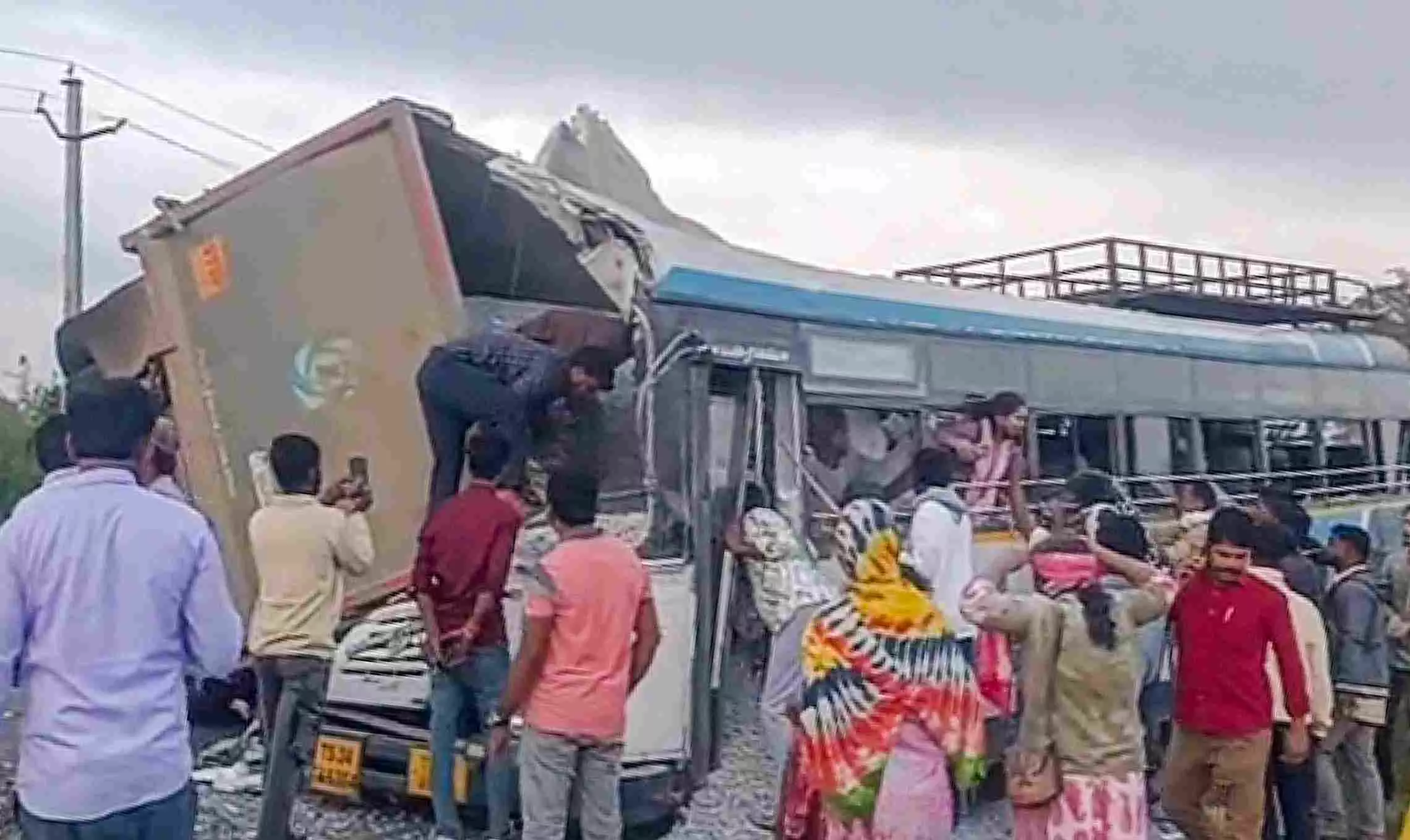
Rescue work underway after a tipper lorry carrying gravel collided head-on with a public transport bus, near Chevella in Ranga Reddy district, Telangana, Monday, Nov. 3, 2025. At least 19 people were killed and four others suffered injuries in the accident. Photo: PTI
Chevella accident: Why tippers have become 'licensed killers' on highways
As red tape overshadows regulation and policing, greedy truck owners and reckless drivers are responsible for road accidents and fatalities

A horrifying road accident near Khanapur Gate in Chevella mandal, on the outskirts of Hyderabad, has once again sent shockwaves across Telangana.
It’s yet another grim reminder of why tipper lorries have come to be known as “licensed killers” on our roads. The behaviour of tipper drivers is once again under the scanner. This tragedy is not an isolated incident, and this time, over 200 people have died and 600 have been injured on this stretch so far this year alone.
A large number of these accidents involve tippers, tractors, and autos. This raises the question: Why are tipper drivers so aggressive on the roads?
Speeding giants
Tippers are increasingly seen tearing through roads at dangerous speeds, earning the title of “licensed killers".
The lack of speed limits, improper driving techniques, owner greed, the financial pressures on drivers who earn more by making more trips, lax enforcement, poorly maintained roads, thrill-seeking behavior, and rampant corruption—all contribute to these roads being bathed with blood due to the number of accidents.
Also read: Kurnool bus fire: ‘Drunk drivers are terrorists,’ says Hyderabad CP Sajjanar
Despite investigations and reports by transport authorities identifying over-speeding as a key issue, government indifference continues to be the biggest failure, AITUC leader Ravindra Nath told The Federal.
Rules ignored
Accidents could be avoided if tippers were subject to specific speed restrictions and route guidelines. In the absence of such rules, they ply the roads during peak hours like any other vehicle, creating serious hazards.
Lack of designated routes, absence of speed guns, and no separate lanes for tippers worsen the problem. If tippers are operated during night hours, and proper maintenance checks, brake lights, and speed governors (also known as a speed limiter, is a device installed in vehicles to limit the maximum speed at which they can operate) must be ensured beforehand.
Transport departments at both state and district levels must clearly define routes for tippers, set strict speed limits, and cap load weights. But currently, such measures either don’t exist or aren’t enforced.
Even where rules are in place, drivers often ignore them with impunity.
Why the recklessness?
The pressure from owners—often linked to per-trip or piece-rate payments—is a major factor in many accidents.
Drivers are given daily trip targets. Owners or contractors fix an income goal for each day and push drivers to meet it. As a result, drivers are forced to speed and make multiple trips, raising the risk of accidents.
Incentivizing danger
Instead of paying drivers by the hour, they’re often paid by the trip or based on tonnage. The more trips they complete, the more they earn—creating a direct link between speed and income.
Also read: Kurnool bus tragedy: Surge in sleeper fire accidents triggers call for nationwide ban
Driven by the need to earn more—either to support their families or to meet basic expenses— they end up overworking and overspeeding.
Lack of oversight
There is no transparent system to regulate speed governors, GPS tracking, weighbridge data, or route enforcement. This allows owners to manipulate systems and increase vehicle speeds unchecked.
Large owners or contractors often work with multiple sub-contractors who have no concern other than maximising income. This pressure trickles down to drivers—turning vehicles into death traps for the public.
Behavioural issues
Although traffic rules exist, they are not strictly enforced, leading to increased accidents. Many drivers lack basic driving skills, and in some cases, use of alcohol or drugs also contributes to their reckless behavior.
Neglect by the transport department in enforcing vehicle fitness checks, installing speed governors, setting trip schedules, providing driver training, and ensuring rest periods is another reason why such accidents continue to happen.
Also read: Kurnool bus fire: Deluxe vehicle had 16 traffic violations, say cops
When owners force drivers to work long hours, they too are equally responsible for the accidents. Unfortunately, after every incident, it’s the innocent who pay with their lives—rarely is any owner held accountable.
Unless there are strict penalties, complaint hotlines, firm speed controls, fines for rule violations, and cancellation of licenses, our roads will continue to run red with blood.
(This article was originally published in The Federal Telangana).

